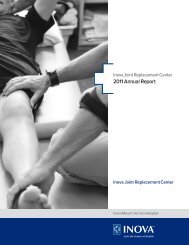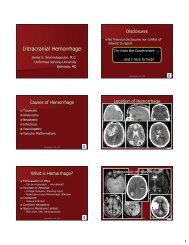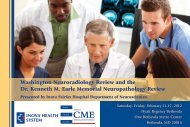Vascular Malformations Smith 12-12-2012 - Inova Health System
Vascular Malformations Smith 12-12-2012 - Inova Health System
Vascular Malformations Smith 12-12-2012 - Inova Health System
You also want an ePaper? Increase the reach of your titles
YUMPU automatically turns print PDFs into web optimized ePapers that Google loves.
2/8/20<strong>12</strong><br />
<strong>Vascular</strong> <strong>Malformations</strong>: Brain<br />
Alice Boyd <strong>Smith</strong>, MD<br />
Chief, Neuroradiology<br />
Department of Radiologic Pathology<br />
Armed Forces Institute of Pathology<br />
Washington, DC<br />
&<br />
Assistant Professor of Radiology & Radiological Sciences<br />
Uniformed Services University of the <strong>Health</strong> Sciences<br />
Bethesda, MD<br />
Disclosures<br />
• Neither myself or my family members have<br />
anything to disclose.<br />
Objectives<br />
• Recognize the different categories of<br />
vascular malformations, their imaging<br />
appearance & their associated<br />
complications<br />
1
2/8/20<strong>12</strong><br />
<strong>Vascular</strong> <strong>Malformations</strong><br />
• Arteriovenous malformation (AVM)<br />
– Classic<br />
– Dural arteriovenous fistula (dAVF)<br />
– Vein of Galen Malformation (VOG)<br />
• Developmental venous anomaly<br />
(DVA)<br />
• Cavernous malformation<br />
• Capillary telangiectasia<br />
<br />
<br />
<br />
<br />
<br />
<br />
Classic AVM<br />
• Arteriovenous shunting & no<br />
intervening capillary bed<br />
– Enlarged feeding artery<br />
– Nidus<br />
– Early draining vein/ varix<br />
• Congenital<br />
– Usually neural tissue in between<br />
• Occur anywhere in brain or spinal<br />
cord<br />
• 98% solitary<br />
– Multiple AVMS usually syndromic:<br />
• Hereditary hemorrhagic<br />
telangiectasia (HHT)<br />
• Cerebrofacial arteriovenous<br />
metameric syndromes (CAMS)<br />
AVM<br />
T2<br />
Nidus =<br />
Conglomeration of<br />
numerous AV shunts &<br />
dysplastic vessels<br />
2
2/8/20<strong>12</strong><br />
Hereditary Hemorrhagic<br />
Telangiectasia<br />
>3 concurrent cerebral AVMS –Rare!<br />
An angiodyplastic disorder with AD inheritance<br />
AVM<br />
• Dysregulated<br />
angiogenesis <br />
continued vascular<br />
remodeling<br />
• Peak age: 20-40 year<br />
old<br />
• Risk of hemorrhage: 2-<br />
4%/year<br />
– ~50% present with<br />
symptoms of<br />
hemorrhage<br />
NECT<br />
AVM Grading: Spetzler -Martin<br />
Scale<br />
• Size<br />
– Small (6 cm) = 3<br />
• Location<br />
– Noneloquent = 0<br />
– Eloquent = 1<br />
• Venous drainage<br />
– Superficial = 0<br />
– Deep = 1<br />
3
2/8/20<strong>12</strong><br />
AVM Imaging: CT<br />
• Variable<br />
Hemorrhage<br />
• Calcification: 25-30%<br />
• Enhance postcontrast<br />
• CTA: Enlarged<br />
arteries & draining<br />
veins<br />
CECT<br />
AVM<br />
NECT<br />
NECT<br />
<br />
<br />
AVM Imaging: MRI<br />
• Flow Voids: “Bag of<br />
worms”<br />
• Variable hemorrhage<br />
– “Blooming” on T2* GRE<br />
• T2: Increased signal<br />
gliosis<br />
• Contrast: Strong<br />
enhancement<br />
• MRA/MRV<br />
T2 FLAIR<br />
4
2/8/20<strong>12</strong><br />
AVM<br />
AVM<br />
AVM Imaging: Conventional<br />
Angiography<br />
• Best method of<br />
imaging<br />
• Must image ICA, ECA<br />
& vertebral circulations<br />
– 27-32% of AVMs have<br />
dual arterial supply<br />
5
2/8/20<strong>12</strong><br />
AVM: Associated Abnormalities<br />
• Flow-related<br />
aneurysm on feeding<br />
artery: 10-15%<br />
• Intranidal aneurysm:<br />
>50%<br />
• <strong>Vascular</strong> “steal”:<br />
Ischemia in adjacent<br />
brain<br />
Increased Risk of Hemorrhage<br />
• Location<br />
– Periventricular<br />
– Basal ganglia<br />
– Thalamus<br />
NECT<br />
• Arterial<br />
– Pedicle aneurysm<br />
– Intranidal aneurysm<br />
• Difficult to detect by MR<br />
• Venous<br />
– Central venous drainage<br />
– Obstruction of venous outflow<br />
– Varix<br />
• Small nidus<br />
NECT<br />
AVM: Treatment<br />
• Embolization<br />
• Radiation: Stereotaxic<br />
radiosurgery<br />
– Eloquent<br />
•Surgery<br />
Combination<br />
6
2/8/20<strong>12</strong><br />
Arteriovenous Fistulas<br />
• Distinguished from AVMs by presence of<br />
direct, high flow fistula between artery &<br />
vein<br />
– Dural AVF (dAVF)<br />
– Cavernous carotid fistula (CCF)<br />
– Vein of Galen malformation<br />
dAVF<br />
• Arteriovenous shunts within<br />
dura<br />
• 10-15% of intracranial<br />
vascular malformations<br />
• 2 types:<br />
– Adult: Tiny vessels in wall of<br />
thrombosed dural venous sinus<br />
typically middle aged & older<br />
patients<br />
• Usually acquired - trauma<br />
– Infantile: Multiple high-flow AVshunts<br />
involving several<br />
thrombosed dural sinuses<br />
SSFSE<br />
<br />
dAVF<br />
T1<br />
SSFSE<br />
T1<br />
7
2/8/20<strong>12</strong><br />
dAVF Grading: Cognard Classification<br />
• Type I: In sinus wall, normal antegrade venous<br />
drainage<br />
• Type II: In main sinus<br />
– A: Reflux into sinus<br />
– B: Reflux into cortical veins: 10-20% hemorrhage<br />
• Type III: Direct cortical drainage<br />
– 40% hemorrhage<br />
• Type IV: Direct cortical drainage + venous ectasia<br />
– 2/3 hemorrhage<br />
• Type V: Spinal perimedullary venous drainage<br />
– Progressive myelopathy<br />
dAVF Grading: Lalwani et al<br />
<br />
dAVF<br />
• Most common near skull<br />
base<br />
– Transverse sinus most<br />
common<br />
• Hemorrhage incidence:<br />
2-4% per year<br />
• Spontaneous closure<br />
rare<br />
– Most are type I<br />
8
2/8/20<strong>12</strong><br />
dAVF Imaging: CT<br />
• NECT: May be normal<br />
• CECT: May see tortuous dural feeders &<br />
enlarged dural sinus<br />
CECT<br />
dAVF Imaging: MRI<br />
• Flow voids around dural<br />
venous sinus<br />
• Thrombosed sinus<br />
• Dilated cortical veins<br />
without parenchymal nidus<br />
• T2: Focal hyperintensity in<br />
adjacent brain<br />
• MRA: May be negative<br />
• MRV: Occluded sinus,<br />
collateral flow<br />
T1+Gd<br />
!!!<br />
dAVF<br />
T2 T2 T1 T1<br />
9
2/8/20<strong>12</strong><br />
dAVF: Conventional Angiography<br />
• Multiple arterial feeders<br />
– Dural/transosseous branches from ECA: most<br />
common<br />
– Tentorial/dural branches from ICA or VA<br />
• Involved dural sinus frequently thrombosed<br />
• Flow reversal in dural sinus/cortical veins<br />
progressive symptoms, risk of hemorrhage<br />
• Tortuous engorged pial veins<br />
”pseudophlebitic pattern”<br />
dAVF<br />
CECT<br />
”Pseudophlebitic pattern”<br />
Carotid Cavernous Fistula (CCF)<br />
• dAVF second most common site<br />
• Abnormal communication between carotid artery &<br />
cavernous sinus<br />
– Enlarges cavernous sinus<br />
– Usually see enlarged superior ophthalmic vein<br />
• CCF may be contralateral to dilated SOV<br />
• Classified by arterial supply & venous drainage<br />
(Barrow):<br />
–A: Direct ICA-cavernous sinus high-flow shunt<br />
– B: Dural ICA branches-cavernous shunt<br />
– C: Dural ECA-cavernous shunt<br />
– D: ECA/ICA dural branches shunt to cavernous sinus<br />
10
2/8/20<strong>12</strong><br />
Venous Drainage<br />
SOV<br />
Superficial Middle<br />
Cerebral V.<br />
Uncal v. Cerebellar<br />
SPS<br />
Pterygoid<br />
& basilar<br />
plexus<br />
IPS<br />
CCF: Imaging<br />
• CT:<br />
– Marked dilation &<br />
enhancement of<br />
cavernous sinus<br />
– May see prominent SOV<br />
• MRI:<br />
– Abnormal flow voids in<br />
cavernous sinus<br />
– Enlargement of<br />
cavernous sinus<br />
<br />
CCF<br />
T1<br />
11
2/8/20<strong>12</strong><br />
CCF<br />
T1+Gd<br />
T2<br />
CCF<br />
SOV<br />
IMAX<br />
Indirect<br />
Courtesy Steven Goldstein, MD<br />
dAVF: Treatment<br />
• Endovascular<br />
• Surgical resection<br />
• Stereotaxic radiosurgery<br />
• Observation:<br />
– Indirect CCF<br />
<strong>12</strong>
2/8/20<strong>12</strong><br />
Vein of Galen Malformation (VOGM)<br />
• Arteriovenous fistula involving<br />
aneurysmal dilatation of<br />
median prosencephalic vein<br />
(MPV)<br />
• Neonatal > infant<br />
presentation<br />
– Rare adult presentation<br />
• Classification:<br />
– Choroidal: Multiple feeders from<br />
pericallosal, choroidal, &<br />
thalmoperforating arteries<br />
– Mural: Few feeders from<br />
collicular or posterior choroidal<br />
arteries<br />
Drains MPV in 50%<br />
Falcine Sinus<br />
T1<br />
VOGM<br />
• Newborns: Most common extracardiac cause of<br />
high-output congestive heart failure<br />
• < 1% of cerebral vascular malformations<br />
CECT<br />
Venous Pouch<br />
VOG Malformation: Prenatal US<br />
13
2/8/20<strong>12</strong><br />
VOG<br />
SSFSE<br />
T2<br />
VOGM: CT Findings<br />
• Venous pouch<br />
• May have<br />
hydrocephalus<br />
• Parenchymal atrophy<br />
• Intraventricular<br />
hemorrhage: Rare<br />
• Post contrast: Avid<br />
enhancement of<br />
feeding arteries and<br />
vein<br />
CECT NCCT<br />
VOGM<br />
14
2/8/20<strong>12</strong><br />
VOGM: MR Imaging<br />
• Flow voids<br />
• T1 hyperintensity<br />
– In pouch <br />
thrombus<br />
– In brain ischemia,<br />
calcification<br />
• DWI: Restricted<br />
diffusion if acute<br />
infarction<br />
T2<br />
T1<br />
VOGM: Angiography<br />
• Choroidal or mural<br />
• Dural venous sinus anomalies<br />
– Falcine sinus in 50%<br />
– +/- absence or stenosis of other sinuses<br />
Choroidal VOGM<br />
15
2/8/20<strong>12</strong><br />
VOGM: Treatment<br />
• Choroidal<br />
– Medical therapy for<br />
congestive heart failure<br />
until 5 or 6 mo<br />
– 5-6 mo: Transcatheter<br />
embolization<br />
• Mural<br />
– Transcatheter<br />
embolization performed<br />
later<br />
VOGM<br />
CECT<br />
Cavernous Malformation<br />
• AKA: Angioma, cavernoma,<br />
cavernous hemangioma<br />
• Variable size intercapillary<br />
vascular spaces, sinusoids, &<br />
larger cavernous spaces<br />
– No intervening brain<br />
– 2 types:<br />
– Inherited: Multiple & bilateral<br />
– Sporadic<br />
16
2/8/20<strong>12</strong><br />
Cavernous Malformation: Imaging<br />
• Little or no mass effect<br />
– Unless complicated by<br />
hemorrhage<br />
• May have internal areas<br />
of thrombosis or<br />
hemorrhage<br />
– Peripheral hemosiderin<br />
causes T2 shortening<br />
resulting in a black<br />
“halo” around the lesion<br />
T2<br />
Cavernous Malformation<br />
T2<br />
Cavernous Malformation<br />
NECT<br />
CT T1+Gd Findings<br />
-Negative : 30-50%<br />
-40-60% Ca++<br />
-No mass effect<br />
-Surrounding brain<br />
normal<br />
-Little or no enhance<br />
-CTA usually negative<br />
17
2/8/20<strong>12</strong><br />
Cavernous Malformation<br />
MRI NECT<br />
-Variable<br />
-”Popcorn ball”<br />
- Surrounding edema in<br />
acute hemorrhage<br />
-Post contrast: minimal/ no<br />
enhance look for DVA!<br />
Angiography: Usually<br />
occult<br />
T2 T1<br />
Cavernous Malformation<br />
• Risk of hemorrhage: 0.25-<br />
0.7%/year<br />
– More common in posterior<br />
fossa lesions<br />
– In patients with prior<br />
hemorrhage annual rate of<br />
rehemorrhage 4.5%<br />
• Treatment:<br />
– Observation: Asymptomatic<br />
or inaccessible lesions<br />
– Surgical excision<br />
– Radiosurgery:<br />
Progressively symptomatic<br />
but surgically inaccessible<br />
T2<br />
Cavernous Malformation<br />
T2<br />
<br />
18
2/8/20<strong>12</strong><br />
Developmental Venous Anomaly (DVA)<br />
• May represent anatomic<br />
variant<br />
– Seen in up to 3% of<br />
autopsies<br />
• Enlarged medullary<br />
veins<br />
• Drain into dural sinus or<br />
deep ependymal vein<br />
• Usually solitary<br />
• “Medusa head” or “palm<br />
tree”<br />
Developmental Venous Anomaly<br />
• Isolated or associated with cavernous<br />
angioma<br />
• Hemorrhage unusual<br />
T1+Gd<br />
DVA Imaging: CT<br />
• Calcification & ischemia may occur in the region<br />
drained most likely due to chronic venous<br />
obstructive disease<br />
–Rare<br />
NECT CECT CECT<br />
19
2/8/20<strong>12</strong><br />
DVA Imaging: MRI<br />
• Surrounding T2 hyperintensity<br />
– May occur in asymptomatic<br />
– Acute edema from thrombosis<br />
– Gliosis from chronic outflow obstruction<br />
DVA<br />
T1+Gd<br />
DVA: Treatment<br />
•NONE!<br />
– Removal may cause<br />
venous infarction<br />
T1+Gd<br />
20
2/8/20<strong>12</strong><br />
Capillary Telangiectasia<br />
• Dilated capillaries<br />
interspersed within<br />
normal brain<br />
• Usually small,<br />
asymptomatic incidental<br />
findings<br />
– Rare reports of<br />
hemorrhage exist<br />
• Most located in<br />
brainstem Pons<br />
Capillary Telangiectasia<br />
• T2: Increased signal<br />
• T2*: Low signal<br />
• Ill defined enhancement after contrast administration:<br />
Stippled/”brush stroke”<br />
• Occult on angiography<br />
• Treatment: None<br />
T1 T1+Gd T2<br />
Capillary Telangiectasia<br />
T1+Gd<br />
E<br />
21
2/8/20<strong>12</strong><br />
Sinus Pericranii<br />
• Communication<br />
between extracranial<br />
venous system &<br />
dural venous sinus<br />
•Rare<br />
• May be congenital or<br />
acquired<br />
Sinus Pericranii<br />
CECT<br />
• CT: Single/multiple bone defects<br />
• <strong>Vascular</strong> enhancement<br />
• Conventional angiogram: Seen during venous phase<br />
Sinus Pericranii<br />
T1+Gd MRV<br />
22
2/8/20<strong>12</strong><br />
Sinus Pericranii<br />
• Spontaneous<br />
regression rare<br />
• Risk of hemorrhage<br />
• Treatment<br />
– Surgery<br />
– Endovascular<br />
T1+Gd<br />
<strong>Vascular</strong> <strong>Malformations</strong><br />
• Arteriovenous<br />
malformation (AVM)<br />
– Classic<br />
– Dural arteriovenous fistula<br />
(dAVF)<br />
– Vein of Galen Malformation<br />
(VOG)<br />
• Developmental venous<br />
anomaly (DVA)<br />
• Cavernous malformation<br />
• Capillary telangiectasia<br />
T1+Gd<br />
Cavernous <strong>Malformations</strong><br />
The End<br />
Thank you!<br />
23
2/8/20<strong>12</strong><br />
References<br />
• Chappell PM, Steinberg GK, Marks MP. Clinically documented hemorrhage<br />
in cerebral arteriovenous malformations: MR characteristics. Radiology<br />
1992; 183: 719.<br />
• Marks MP, Lane B, Steinberg GK, Chang PJ. Hemorrhage in intracerebral<br />
arteriovenous malformations: angiographic determinants. Radiology 1990;<br />
176: 807.<br />
• Marks MP, Lane B, Steinberg GK, Snipes GJ. Intranidal aneurysms in<br />
cerebral arteriovenous malformations: evaluation and endovascular<br />
treatment. Radiology 1992; 183: 355.<br />
• Meder JF, Oppenheim C, Blustajn J et al. Cerebral arteriovenous<br />
malformations: the value of radiologic parameters in predicting response to<br />
radiosurgery. AJNR Am. J. Neuroradiol., Sep 1997; 18: 1473 - 1483.<br />
• Putman CM, Chaloupka JC, Fulbright RK et al. Exceptional multiplicity of<br />
cerebral arteriovenous malformations associated with hereditary<br />
hemorrhagic telangiectasia (Osler-Weber- Rendu syndrome)<br />
AJNR Am. J. Neuroradiol., Oct 1996; 17: 1733 - 1742.<br />
• Lucian Ai, Houdart E, Mounayer C et al. Spontaneous Closure of Dural<br />
Arteriovenous Fistulas: Report of Three Cases and Review of the Literature<br />
AJNR Am. J. Neuroradiol., May 2001; 22: 992 - 996.<br />
References<br />
• Kwon BJ, Han MH, Kang H, Chang K. MR Imaging Findings of Intracranial Dural<br />
Arteriovenous Fistulas: Relations with Venous Drainage Patterns.AJNR Am. J.<br />
Neuroradiol., Nov 2005; 26: 2500 - 2507.<br />
• Lee S, Willinsky RA, Montanera W, terBrugge KG. MR Imaging of Dural<br />
Arteriovenous Fistulas Draining into Cerebellar Cortical Veins. AJNR Am. J.<br />
Neuroradiol., Sep 2003; 24: 1602 - 1606.<br />
• Willinsky R, Goya M, terBrugge K, Montanera W. Tortuous, Engorged Pial Veins in<br />
Intracranial Dural Arteriovenous Fistulas: Correlations with Presentation, Location,<br />
and MR Findings in <strong>12</strong>2 Patients.AJNR Am. J. Neuroradiol., Jun 1999; 20: 1031 -<br />
1036.<br />
• Dillon WP. Cryptic vascular malformations: controversies in terminology, diagnosis,<br />
pathophysiology, and treatment. AJNR Am. J. Neuroradiol., Nov 1997; 18: 1839 -<br />
1846.<br />
• Vilanova JC, Barceló J, Smirniotopoulos JG et al. Hemangioma from Head to Toe:<br />
MR Imaging with Pathologic Correlation. RadioGraphics 2004; 24: 367-385.<br />
• Kiyosue H, Hori Y, Okahara M et al. Treatment of Intracranial Dural Arteriovenous<br />
Fistulas: Current Strategies Based on Location and Hemodynamics, and Alternative<br />
Techniques of Transcatheter Embolization. RadioGraphics 2004; 24: 1637-1653.<br />
• Carpenter JS, Rosen CL, Bailes JE, Gailloud P. Sinus Pericranii: Clinical and<br />
Imaging Findings in Two Cases of Spontaneous Partial Thrombosis.AJNR Am. J.<br />
Neuroradiol., Jan 2004; 25: <strong>12</strong>1 - <strong>12</strong>5.<br />
References<br />
• Morón FE, Klucznik RP, Mawad ME, Strother CM. Endovascular<br />
Treatment of High-Flow Carotid Cavernous Fistulas by Stent-Assisted Coil<br />
Placement. AJNR Am. J. Neuroradiol., Jun 2005; 26: 1399 - 1404<br />
• Gomez F, Escobar W, Gomez AM et al. Treatment of Carotid Cavernous<br />
Fistulas Using Covered Stents: Midterm Results in Seven Patients. AJNR<br />
Am. J. Neuroradiol., Oct 2007; 28: 1762 - 1768.<br />
• Chen CC, Chang PC, Shy C et al. CT Angiography and MR Angiography<br />
in the Evaluation of Carotid Cavernous Sinus Fistula Prior to Embolization:<br />
A Comparison of Techniques. AJNR Am. J. Neuroradiol., Oct 2005; 26:<br />
2349 - 2356<br />
• Wilms G, Bleus E, Demaerel P et al. Simultaneous occurrence of<br />
developmental venous anomalies and cavernous angiomas. AJNR Am. J.<br />
Neuroradiol., Aug 1994; 15: <strong>12</strong>47 - <strong>12</strong>54.<br />
• Lee C, Pennington MA, Kenney CM, 3 rd . MR evaluation of developmental<br />
venous anomalies: medullary venous anatomy of venous angiomas. AJNR<br />
Am. J. Neuroradiol., Jan 1996; 17: 61 - 70<br />
• Brunereau L, Labauge P, Tournier-Lasserve E et al. Familial Form of<br />
Intracranial Cavernous Angioma: MR Imaging Findings in 51 Families.<br />
Radiology 2000; 214: 209<br />
24

















